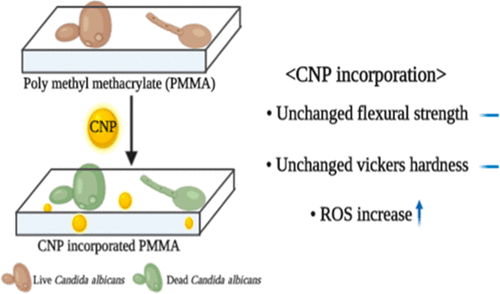当前位置:
X-MOL 学术
›
ACS Biomater. Sci. Eng.
›
论文详情
Our official English website, www.x-mol.net, welcomes your
feedback! (Note: you will need to create a separate account there.)
Ceria-Incorporated Biopolymer for Preventing Fungal Adhesion
ACS Biomaterials Science & Engineering ( IF 5.4 ) Pub Date : 2020-12-04 , DOI: 10.1021/acsbiomaterials.0c01039 Sung-Min Park 1, 2 , Dong-Ae Kim 3, 4 , Jeong-Ki Jo 4 , Soo-Kyung Jun 1, 2, 5 , Tae-Su Jang 6 , Hae-Won Kim 1, 2, 4, 7 , Jung-Hwan Lee 1, 2, 4, 7 , Hae-Hyoung Lee 1, 2, 4, 7
ACS Biomaterials Science & Engineering ( IF 5.4 ) Pub Date : 2020-12-04 , DOI: 10.1021/acsbiomaterials.0c01039 Sung-Min Park 1, 2 , Dong-Ae Kim 3, 4 , Jeong-Ki Jo 4 , Soo-Kyung Jun 1, 2, 5 , Tae-Su Jang 6 , Hae-Won Kim 1, 2, 4, 7 , Jung-Hwan Lee 1, 2, 4, 7 , Hae-Hyoung Lee 1, 2, 4, 7
Affiliation

|
Although biopolymers are widely used in biomedical fields, the issue of poor antimicrobial properties remains unsolved, leading to a potential increase in infections. Here, ceria nanoparticles (CNPs) were incorporated into a representative biopolymer, poly(methyl methacrylate) (PMMA), for drug-free antimicrobial properties. After characterizing the CNPs and surface/mechanical properties of the CNP-PMMA nanocomposite, antiadhesive effects against Candida albicans, the most common fungal species responsible for fungal infections, were determined using metabolic activity assays, and the underlying microbial antiadhesive mechanism was revealed. Hydrothermally fabricated CNPs showed a size of ∼20 nm with a zeta potential of 12 ± 2.3 mV and showed catalytic properties as a ROS modulator. Successful incorporation of CNPs into PMMA up to 2 wt % was confirmed by EDS analysis. The surface roughness and mechanical properties such as flexural strength and modulus were relatively unchanged up to 2 wt %. In contrast, the surface energy increased, and the Vickers hardness decreased in the 2 wt % PMMA compared with the control. A drop of up to 90% of adherent Candida albicans was observed in CNP-incorporated PMMA, which was confirmed and quantified via fungus staining images. The antiadhesive mechanism was revealed from the direct antimicrobial effects of CNP via the upregulation of the intracellular ROS level. Taken together, the antimicrobial-adhesive properties of the CNP-PMMA nanocomposite suggest the potential usefulness of CNP as a promising drug-free antimicrobial ingredient for biopolymers, which could lead to the prevention of microbial-induced complications in clinical settings.
中文翻译:

掺有氧化铈的生物聚合物可防止真菌粘附
尽管生物聚合物广泛用于生物医学领域,但抗菌性能差的问题仍未解决,导致感染的潜在增加。在此,将二氧化铈纳米颗粒(CNP)掺入具有代表性的生物聚合物,即聚甲基丙烯酸甲酯(PMMA),以实现无毒抗菌性能。在表征了CNP和CNP-PMMA纳米复合材料的表面/机械性能后,它对白色念珠菌具有抗粘连作用,最重要的真菌种类负责真菌感染,使用代谢活性测定法进行了确定,并揭示了潜在的微生物抗粘附机制。水热制备的CNP的尺寸约为20 nm,ζ电位为12±2.3 mV,并具有作为ROS调节剂的催化性能。通过EDS分析证实CNP成功地掺入到PMMA中至多2重量%。直至2wt%,表面粗糙度和机械性能例如挠曲强度和模量相对不变。相反,与对照相比,在2wt%的PMMA中,表面能增加,并且维氏硬度降低。最多可粘附90%的白色念珠菌在掺有CNP的PMMA中观察到了这种现象,并通过真菌染色图像对其进行了确认和定量。通过细胞内ROS水平的上调,CNP的直接抗菌作用揭示了其抗粘连机制。综上所述,CNP-PMMA纳米复合材料的抗微生物粘附特性表明,CNP作为一种有前途的生物聚合物无药抗菌成分具有潜在的实用性,可在临床环境中预防由微生物引起的并发症。
更新日期:2020-12-04
中文翻译:

掺有氧化铈的生物聚合物可防止真菌粘附
尽管生物聚合物广泛用于生物医学领域,但抗菌性能差的问题仍未解决,导致感染的潜在增加。在此,将二氧化铈纳米颗粒(CNP)掺入具有代表性的生物聚合物,即聚甲基丙烯酸甲酯(PMMA),以实现无毒抗菌性能。在表征了CNP和CNP-PMMA纳米复合材料的表面/机械性能后,它对白色念珠菌具有抗粘连作用,最重要的真菌种类负责真菌感染,使用代谢活性测定法进行了确定,并揭示了潜在的微生物抗粘附机制。水热制备的CNP的尺寸约为20 nm,ζ电位为12±2.3 mV,并具有作为ROS调节剂的催化性能。通过EDS分析证实CNP成功地掺入到PMMA中至多2重量%。直至2wt%,表面粗糙度和机械性能例如挠曲强度和模量相对不变。相反,与对照相比,在2wt%的PMMA中,表面能增加,并且维氏硬度降低。最多可粘附90%的白色念珠菌在掺有CNP的PMMA中观察到了这种现象,并通过真菌染色图像对其进行了确认和定量。通过细胞内ROS水平的上调,CNP的直接抗菌作用揭示了其抗粘连机制。综上所述,CNP-PMMA纳米复合材料的抗微生物粘附特性表明,CNP作为一种有前途的生物聚合物无药抗菌成分具有潜在的实用性,可在临床环境中预防由微生物引起的并发症。











































 京公网安备 11010802027423号
京公网安备 11010802027423号